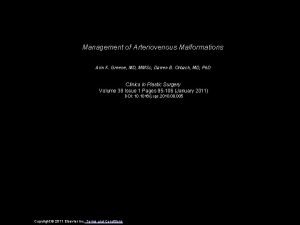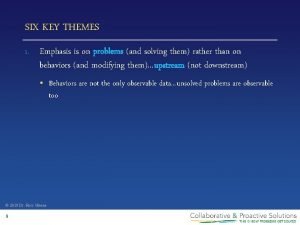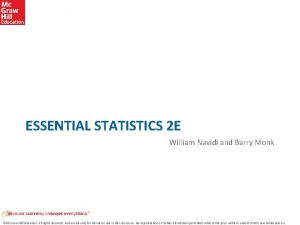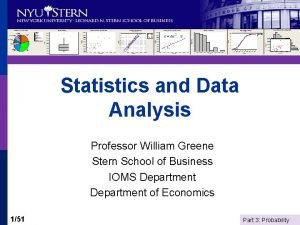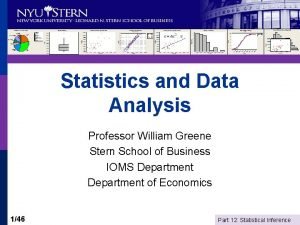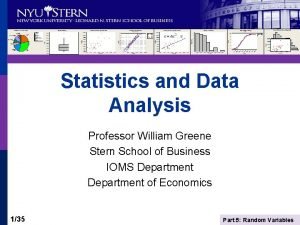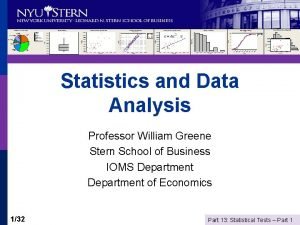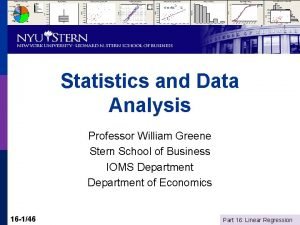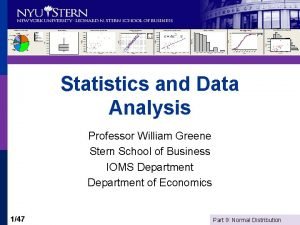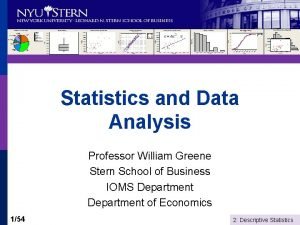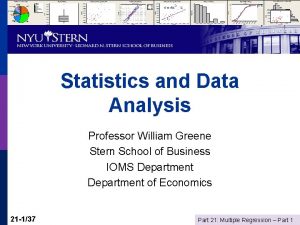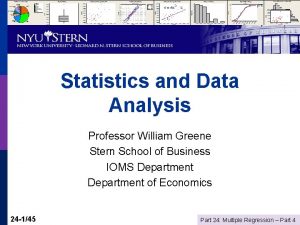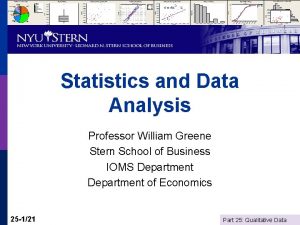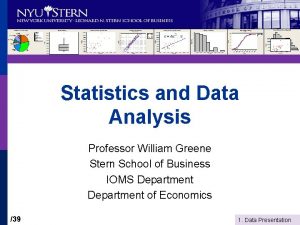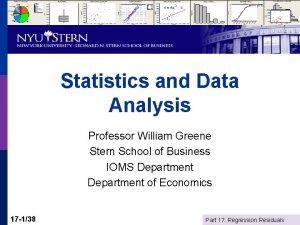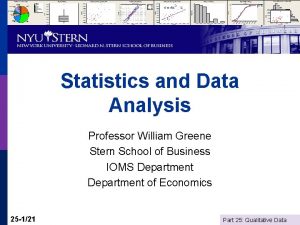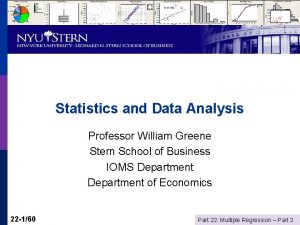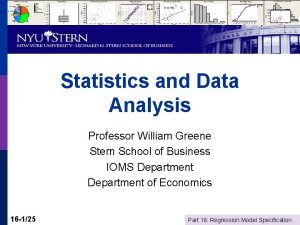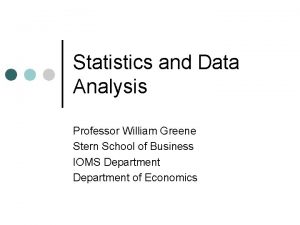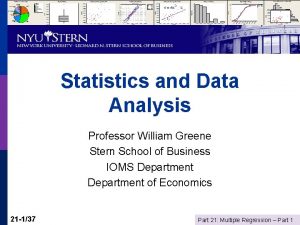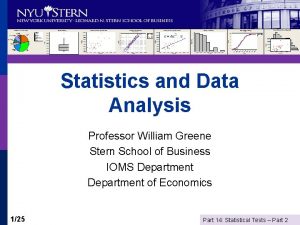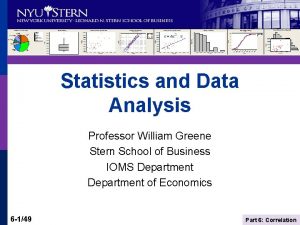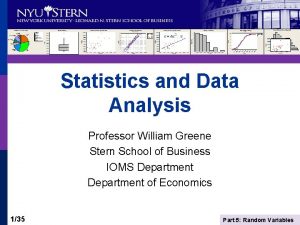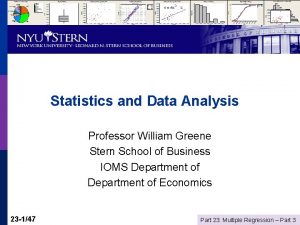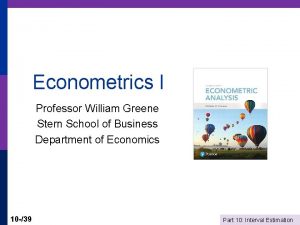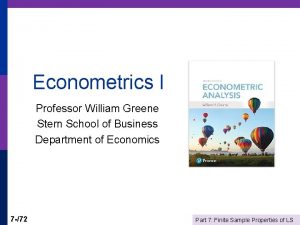Statistics and Data Analysis Professor William Greene Stern


























- Slides: 26

Statistics and Data Analysis Professor William Greene Stern School of Business IOMS Department of Economics 20 -1/26 Part 20: Aspects of Regression

Statistics and Data Analysis Part 20 – Aspects of Regression 20 -2/26 Part 20: Aspects of Regression

Regression Models Using the regression model to predict the value of the dependent variable. p ‘Cleaning’ the data to remove what look like extreme values. p n n 20 -3/26 Trimming – removing values with extreme ‘x’ Truncation – removing values with extreme ‘y’ Part 20: Aspects of Regression

Prediction p p Use of the model for prediction Use “x” to predict y based on y = α+βx+ε Sources of uncertainty n n 20 -4/26 Predicting “x” first Using sample estimates of α and β (and, possibly, σ) Can’t predict noise, ε Predicting outside the range of experience – uncertainty about the reach of the regression model. Part 20: Aspects of Regression

Base Case Prediction p p Predict y with a given value of x*: We would use the regression equation. n n n p Sources of prediction error n n 20 -5/26 True y = α + βx* + ε Since α and β must be estimated, the obvious estimate is y = a + bx We have no prediction for ε other than 0. Can never predict ε at all The farther from the center of experience, the greater is the uncertainty. Part 20: Aspects of Regression

A Prediction Interval The usual 95% Due to ε Due to estimating α and β with a and b (Remember the empirical rule, 95% of the distribution will be within two standard deviations. ) 20 -6/26 Part 20: Aspects of Regression

Slightly Simpler Formula for Prediction 20 -7/26 Part 20: Aspects of Regression

Prediction from Internet Buzz Regression 20 -8/26 Part 20: Aspects of Regression

Prediction Interval for Buzz =. 8 20 -9/26 Part 20: Aspects of Regression

Predicting Using a Loglinear Equation p Predict the log first n n 20 -10/26 Prediction of the log Prediction interval – (Lower to Upper) p Prediction = exp(lower) to exp(upper) p This produces very wide intervals. Part 20: Aspects of Regression

Interval Estimates for the Sample of Signed Monet Paintings Regression Analysis: ln (US$) versus ln (Surface. Area) The regression equation is ln (US$) = 2. 83 + 1. 72 ln (Surface. Area) Predictor Coef SE Coef T P Constant 2. 825 1. 285 2. 20 0. 029 ln (Surface. Area) 1. 7246 0. 1908 9. 04 0. 000 S = 1. 00645 R-Sq = 20. 0% R-Sq(adj) = 19. 8% Mean of ln (Surface. Area) = 6. 72918 20 -11/26 Part 20: Aspects of Regression

Prediction for An Out of Sample Monet Claude Monet: Bridge Over a Pool of Water Lilies. 1899. Original, 36. 5”x 29. ” 20 -12/26 Part 20: Aspects of Regression

Predicting y when the Model Describes log y 20 -13/26 Part 20: Aspects of Regression

Van Gogh: Irises 39. 5 x 39. 125. Prediction by our model = $17. 903 M Painting is in our data set. Sold for 16. 81 M on 5/6/04 Sold for 7. 729 M 2/5/01 Last sale in our data set was in May 2004 Record sale was 6/25/08. market peak, just before the crash. 20 -14/26 Part 20: Aspects of Regression

Uncertainty in Prediction The interval is narrowest at x* = , the center of our experience. The interval widens as we move away from the center of our experience to reflect the greater uncertainty. (1) Uncertainty about the prediction of x (2) Uncertainty that the linear relationship will continue to exist as we move farther from the center. 20 -15/26 Part 20: Aspects of Regression

http: //www. nytimes. com/2006/05/16/arts/design/16 oran. html 20 -16/26 Part 20: Aspects of Regression

167” (13 feet 11 inches) "Morning", Claude Monet 1920 -1926, oil on canvas 200 x 425 cm, Musée de l Orangerie, Paris France. Left panel 26. 2” (2 feet 2. 2”) 78. 74” (6 Feet 7 inch) 20 -17/26 32. 1” (2 feet 8 inches) Part 20: Aspects of Regression

Predicted Price for a Huge Painting 20 -18/26 Part 20: Aspects of Regression

Prediction Interval for Price 20 -19/26 Part 20: Aspects of Regression

118” (9 feet 10 inches) 32. 1” (2 feet 8 inches) Average Sized Monet 157” (13 Feet 1 inch) 26. 2” (2 feet 2. 2”) Use the Monet Model to Predict a Price for a Dali? Hallucinogenic Toreador 20 -20/26 Part 20: Aspects of Regression

20 -21/26 Part 20: Aspects of Regression

Forecasting Out of Sample Regression Analysis: G versus Income The regression equation is G = 1. 93 + 0. 000179 Income Predictor Coef SE Coef T P Constant 1. 9280 0. 1651 11. 68 0. 000 Income 0. 00017897 0. 00000934 19. 17 0. 000 S = 0. 370241 R-Sq = 88. 0% R-Sq(adj) = 87. 8% How to predict G for 2017? You would need first to predict Income for 2017. How should we do that? Per Capita Gasoline Consumption vs. Per Capita Income, 1953 -2004. 20 -22/26 Part 20: Aspects of Regression

Data Trimming All 430 Sales: 4. 290 + 1. 326 log area Data Subset Worksheet Rows that match condition. 377 Sales of area 403. 4 < area < 2981. 0 (log > 6 and < 8) 3. 068 + 1. 662 log area The sample is restricted to particular values of X – area between 403 and 2981. Trimming is generally benign, but the regression should be understood to apply to the specified range of x. The trimming is based on a variable not related to the underlying noise in Y. 20 -23/26 Part 20: Aspects of Regression

Truncation Entire Sample: 5. 290+1. 326 log Area Subsample: 500, 000 < Price < 3, 000 11. 44 + 0. 3821 log Area Truncation based on the values of the dependent variable is VERY BAD. It reduces and sometimes destroys the relationship. This is one reason we resist removing “outliers” from the sample. 20 -24/26 Part 20: Aspects of Regression

Where Have We Been? p p Sample data – describing, display Probability models n n p p p 20 -25/26 Models for random experiments Models for random processes underlying sample data Random variables Models for covariation of random variables Linear regression model for covariation of a pair of variables Part 20: Aspects of Regression

Where Do We Go From Here? p Simple linear regression n p Thus far, mostly a descriptive device Use for prediction and forecasting Yet to consider: Statistical inference, testing the relationship Multiple linear regression n n 20 -26/26 More than one variable to explain the variation of Y More elaborate model building Part 20: Aspects of Regression
 Aft end
Aft end Promotion from assistant to associate professor
Promotion from assistant to associate professor Kylie greene
Kylie greene The tenth man graham greene summary
The tenth man graham greene summary When to use green's theorem vs stokes theorem
When to use green's theorem vs stokes theorem Graham greene destructors
Graham greene destructors Linda r greene
Linda r greene Journey without maps
Journey without maps Robert greene shakespeare
Robert greene shakespeare Arin greene
Arin greene Linda r greene
Linda r greene Problem solving plan (plan b flowchart)
Problem solving plan (plan b flowchart) Ross greene plan a b c
Ross greene plan a b c Maxine greene releasing the imagination
Maxine greene releasing the imagination Ericka simpson md
Ericka simpson md Eric greene course
Eric greene course 7 secrets of the sensitive
7 secrets of the sensitive Uzuri pease-greene
Uzuri pease-greene Citl ucsc
Citl ucsc Introduction to statistics what is statistics
Introduction to statistics what is statistics William navidi essential statistics pdf
William navidi essential statistics pdf William navidi elementary statistics pdf
William navidi elementary statistics pdf William navidi essential statistics pdf
William navidi essential statistics pdf Essential statistics william navidi pdf
Essential statistics william navidi pdf Barry navidi
Barry navidi Personal network analysis
Personal network analysis Människans åtta åldrar
Människans åtta åldrar









